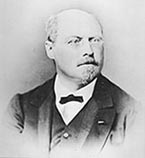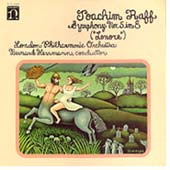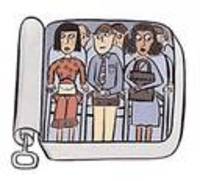I am listening to the second violin concerto of Joseph Joachim Raff, a Swiss/German composer of the 19th century. One thing that can happen after decades of listening to classical music is that one gets off the beaten path and explores the byways of musical history. B eethoven, heard it. Mozart, done that. Now I have pretty much run myself through the standard repertory and am onto Raff, a fine composer with a gift for orchestration and melody. There is an excellent website dedicated to restoring his reputation, which once loomed as large as that of Brahms and Wagner.
eethoven, heard it. Mozart, done that. Now I have pretty much run myself through the standard repertory and am onto Raff, a fine composer with a gift for orchestration and melody. There is an excellent website dedicated to restoring his reputation, which once loomed as large as that of Brahms and Wagner.
I am a sucker for Romantic-era music, the time that roughly spans 1830 to 1900, and which takes us from Mendelssohn through Schumann, Berlioz, Wagner, Raff, Tchaikovsky, Brahms, and Dvorak. This is when “program music” emerged, in which the orchestra was liberated from the old forms and was used to describe something physical, literary, or emotional: a sojourn in the Alps, the witches’ Sabbath, the love of Romeo and Juliet, a hero’s journey. Proponents of this approach, notably Wagner and Liszt, called it the “music of the future.” Others, notably Brahms, thought it was balderdash.
But it stuck. We would not have film music today were it not for the leitmotivs of Wagner, the Symphonie Fantastique of Berlioz, or the Lenore Symphony of Raff. Lenore is Raff’s best-known work, championed in our time by the late film composer Bernard Hermann. It is based upon a poem about a woman who is reunited with her soldier-love, wh o turns out to be a little bit dead and ultimately a tad skeletal. In 1872 this was serious art; today it is still fun, right down to the orchestral rendering of the hoofbeats in the “Rapid Gallop of the Dead.”
o turns out to be a little bit dead and ultimately a tad skeletal. In 1872 this was serious art; today it is still fun, right down to the orchestral rendering of the hoofbeats in the “Rapid Gallop of the Dead.”
As was fashionable at the time, Raff often wrote descriptions of his music that were intended to let the listener know what it was supposed to be about. (The downfall of program music is that one usually cannot understand what is being described without the benefit of some CliffsNotes from the composer.)
Concerning his second violin concerto, composed in 1877, Raff wrote, in the flowery language of his era: 1st movement: “You feel your life’s frail bark foundering, the tempest rages, and in vain do you pit your pious courage against the fury.” 2nd movement: “Coming from distant heights, the soft breath of consolation and hope nears; you feel a reviving warmth, and peace enters your heart.” 3rd movement: “The tempest seems about to resume, but you heed it not, for the pain that oppressed your heart has given way to joy and pleasure.”
Someone once commented on my blog and said he was amazed that I managed to somehow turn everything into a discussion of chronic lymphocytic leukemia. Can I do this with Raff’s violin concerto?
Is the Pope Catholic?
Does a bear shit in the woods?
Onward, dear reader!
Infusionary Raff
I brought my CD of Raff’s violin concerto to the infusion room of my hem/onc’s office, where I recently completed my latest treatment, which involved Rituxan dosing on a more frequent schedule, accompanied by some Beta-Glucan on the side. (I described the treatment plan in The Way of the Tortoise, Parts 1 and 2.)
For those who don’t know it -- and, given Raff's obscurity, I assume that is almost everyone on the planet -- the first movement of Raff’s concerto contains what one writer has called a “a quietly beautiful and autumnal melody” that is developed into a chorale-like theme said to represent “pious courage.” (Listen to the first mp3 here, in which you can hear a full statement of i t at the end, starting at 1:30.) To me, anyway, the music is affecting, with a heartfelt, longing quality that lifts it from mere beauty to the level of a spiritual cry.
t at the end, starting at 1:30.) To me, anyway, the music is affecting, with a heartfelt, longing quality that lifts it from mere beauty to the level of a spiritual cry.
In some ways, Raff’s concerto reminds me of my struggle with CLL: I can feel my life’s frail bark foundering, and I must throw my courage, however pious or not, into the fight. Coming from distant heights, consolation and hope enter. On a mundane level, hope comes from workaday advances in medicine. But on a more profound level, I take consolation in knowing that my struggle for my life is part of the eternal ebb and flow of creation, and that some form of grace may exist at the end of this process. If this is fatalism, it is a liberating kind of it. When the tempest resumes -- the disease again rears its head -- the pain of the struggle is kept in context, my joy and pleasure in life and faith in its course assert themselves. The issue becomes not quantity of time but of qualities that transcends time.
And, so, each of us participates in our own epic struggle, which is what this disease is: a long journey, a vision quest as much as a physical fight, an enforced opportunity to face our fears and find something more powerful, the struggle of the mortal in search of the enduring.
Needless to say, I am a romantic at heart, and I could have been at home in the Romantic era -- had it been accompanied by air conditioning and toilet paper.
My latest treatment
Against this backdrop, and with Raff’s music filling my headphones as I sat in the infusion chair, I proceeded with treatment: The plan was to do Rituxan three days a week for two weeks, 375 mg/m2 each time. To this I added 2000 mg of Beta-Glucan daily, the same product being used in a clinical trial of CLL patients at the University of Louisville, Kentucky.
My CBC was done before each infusion, so I had the opportunity to see what was happening more frequently than in the past.
The treatment, which began exactly one year from the day I had last started treatment, opened with a bang. My absolute lymphocyte count of 153,600 dropped to 48,200 within 48 hours. My chipmunky neck began to slim down. Another 48 hours put my count at 26,600. And that’s about where it stopped. By the middle of the second week I was reaching my Rituxan plateau, both in terms of nodes and counts. This is a place I have reached every time, though in this case it was reached at a higher count -- 22,600 after the fifth infusion versus 5,100 a year ago -- and with somewhat less reduction of nodes. My doctor suggested, and I concurred, that there was little point in doing the sixth infusion. And if Rituxan’s effectiveness was exhausted at this point, adding a steroid to it for a couple more infusions wouldn’t do much good, either.
And so this remission is more imperfect than all the others I have had. I was n ot expecting great things -- in fact, in a previous post I said I would be happy enough with an old clunker as long as it got me down the road. That is what I got, even if it sometimes seems to resemble the car driven by the Flintstones. Some of the nodes began to return within a month, far sooner than in the past (though the bothersome pelvic nodes I have written about were made a bit more tolerable).
ot expecting great things -- in fact, in a previous post I said I would be happy enough with an old clunker as long as it got me down the road. That is what I got, even if it sometimes seems to resemble the car driven by the Flintstones. Some of the nodes began to return within a month, far sooner than in the past (though the bothersome pelvic nodes I have written about were made a bit more tolerable).
What have I learned?
Keep in mind that I am providing you with an anecdotal report, not a clinical study.
It is possible that I am simply more resistant to Rituxan than I was before. This is consistent with some other case histories I have heard about, in which the drug becomes less effective when used over time. Prior to starting my latest treatment, I had had 20 infusions of Rituxan during the preceding 33 months.
Whether my past response was better because I was less resistant to the drug, or because the usual dosing schedule of once a week for eight weeks simply works better, is a big unknown. Dr. John Byrd, whom I saw in June, expressed a fair amount of faith in his frequent-dosing protocol. Indeed, it is possible that the more intensive dosing brought me a better remission than I would have had otherwise; it is also possible that just the opposite is true.
I do surmise from the huge response at the start, which soon petered out, that my complement may have become quickly exhausted. And/or that Rituxan shaving occurred, in which, overwhelmed by CD 20-Rituxan complexes, my CLL cells were transported to the liver, shorn of the offending pair, and returned to the bloodstream.
I am guessing, but it is only a guess, that had I received an infusion of complement via fresh frozen plasma -- this was tried on one patient in Israel with great success -- my response would have been better and deeper than it was. (Alas, this was not a practical move for me and carries the risk of infection from the donated plasma.) But this idea is not without merit. As Ron Taylor (of complement-depletion-Rituxan-shaving fame) and some colleagues noted in a 2004 study: “Therefore, we suggest that if complement is required to promote killing of RTX-opsonized cells, then use of C2, or compatible fresh frozen plasma as a complement source, may enhance the action of RTX in patients with reduced or depleted complement levels.”
use of C2, or compatible fresh frozen plasma as a complement source, may enhance the action of RTX in patients with reduced or depleted complement levels.”
As to Beta-Glucan, there is no way of measuring its effect. Like EGCG, it may work better in some people than in others. All I can say is that it is not, in my case, a miracle "drug," nor is it something I would necessarily use again.
Trial and error is the hallmark of CLL management, it seems. One patient responds well to Treatment A, another doesn’t. One develops resistance to a drug sooner, another does later. We can get some clues as to how we will respond from a FISH test, for example, but there are still no guarantees. Our heterogeneous disease, which runs the spectrum from the merely irksome to the immediately life-threatening, makes each patient a laboratory of one.Looking ahead
It is clear in my lab that the next step has to involve something equal in power to Rituxan, not just a booster on the order of Beta-Glucan, EGCG, G-CSF, or GM-CSF. I meet with my doctor in January and expect, unless the unexpected happens, that we might aim for some kind of treatment in April or so, which would be six months after the conclusion of the last one. Rituxan will still be part of it simply because it seems to potentiate all other drugs in CLL therapy, I am still responding to it to some degree, and it remains the least toxic of the available treatment drugs.
What to add to it? The candidates are simple: a fairly high-dose steroid, mainly useful for reducing nodes. Or chlorambucil (CB), perhaps with a little dexamethasone added. The dex, aside from its node-reducing properties, may help protect the bone marrow from side effects of the CB. (And before I go any further, let me state the obvious, which does need repeating from time to time: The opinions expressed in this blog are mine and may not be right for you. As with any treatment choice, I urge you to do your homework, consult with your doctor(s), and reach your own conclusions.)
Internet-savvy patients are familiar with the Rituxan + HDMP (High Dose Methylprednisolone) trials at UC San Diego, which are sometimes followed with Campath to solidify responses. Much has been written about R+HDMP, pro and con, and I have personally gotten earfuls from both sides of the argument. The bottom line, as I see it, is that chemo-naïve patients at UCSD seem to have had some good success with it. We CLL patients live in a world where there are few elegant choices. Everything carries some risk. R + HDMP, on the sliding scale of crap that can happen during and because of treatment, is preferable -- if properly managed -- to anything involving fludarabine, IMHO. If my real-world choice boils down to R + HDMP or RF/RFC, I know which one I'll take.
Dr. Michael Keating at MD Anderson is trying a “mini” version of R + HDMP, one that may have fewer problems in terms of steroidal immunosuppression (and which probably will be less effective as well). Nonetheless, it may be enough to keep me going, and to allow me to test the waters in steroid-land to see how well I can handle it given my skin cancer issues. The Keating protocol is Rituxan once a week for four weeks at 375 mg/m2 along with 500 mg of Solumedrol each week, Solumedrol being the trade name for methylprednisolone.
Alternately, I could forget the Solumedrol and add dexamethasone in node-busting dosages. But a synergy between Rituxan and methylprednisolone has been demonstrated, while its effectiveness with dexamethasone is, to my knowledge, less certain.
The other option, R + CB, may be especially useful if my marrow heads south. (So far it is holding on, but my hemoglobin has slid into low-normal -- the 13s -- from middle normal, where it had pretty much been since diagnosis.) R + CB has been advocated by Dr. Terry Hamblin, my favorite CLL expert, and used successfully by any number of patients. My main concern here is whether it would be mutagenic, putting me at risk for developing a p53 (aka 17p) mutation. There is a study that shows that alkalyting agents, namely chlorambucil and cyclophosphamide, may be implicated in this; p53 deletions were found in 18 out of 62 patients treated with those alkalytors, compared to 4 out of 60 “alkalytor-naïve” patients. Using low-dose chlorambucil may minimize this risk, but provides no guarantees. And p53-deleted CLL is the most drug-resistant and the hardest to kill. To borrow another Romantic-era musical metaphor, think Gotterdammerung.
A final consideration is that "mini" R + Solumedrol or R + dexamethasone still leaves in reserve the possibility of 1) using full-fledged R + HDMP, and/or 2) using R + CB and getting the full benefit from the CB. So one might argue, logically, that when playing for time and looking at unburnt bridges, R + a non-high-dose steroid might be the better next step -- provided it appears to be up to the task at hand.
And what about the combination plate special (or WEP, for Whole Enchilada Protocol), if something pretty serious is needed: Keating’s “mini” R + Solumedrol with some chlorambucil thrown in?
I will, of course, seek to answer these questions to the best of my ability. And I will, when the going gets rough, turn my ears to Raff. He wrote more than 200 works, many of which have now been recorded. His sixth symphony is subtitled “Lived, strove, suffered, fought.” Sounds like music for CLL.
A HOLIDAY NOTE
This is probably my last post of the year. Marilyn and I have relatives to visit, places to go, and work to do. On December 26, we celebrate the High Holy Day of the eBay calendar: 10-cent listing day. For some reason, the week after Christmas is always our best (and busiest) week of the year when it comes to auctions. So I will see you in the new year, and I wish you all a joyful and happy holiday season. May Santa bring us all spontaneous remissions!
 also caught by my brother after the gathering ended.
also caught by my brother after the gathering ended. of flying, when they actually cleaned the planes between uses, right down to replacing the paper things that were hung over the top of the headrests for sanitary reasons. You could fit into the seats, and they gave you three meal choices in coach. Things have now deteriorated to the point that I would not be surprised to see people boarding with babushkas and chickens. But I digress.
of flying, when they actually cleaned the planes between uses, right down to replacing the paper things that were hung over the top of the headrests for sanitary reasons. You could fit into the seats, and they gave you three meal choices in coach. Things have now deteriorated to the point that I would not be surprised to see people boarding with babushkas and chickens. But I digress.









